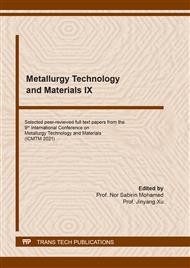[1]
A. L. Greer, Mater. Today 12 (2009) 14-22.
Google Scholar
[2]
W. H. Wang, Prog. Mater. Sci. 106 (2019) 100561.
Google Scholar
[3]
M. Miller, P. Liaw (Eds.), Bulk Metallic Glasses, Springer, New York, (2008).
Google Scholar
[4]
C. Suryanarayana, A. Inoue, Bulk Metallic Glasses, CRC Press, New York, (2011).
Google Scholar
[5]
J. F. Löffler, P. Thiyagarajan, W. L. Johnson, J. Appl. Cryst. 33 (2020) 500-503.
Google Scholar
[6]
U. Geyer, S. Schneider, W. L. Johnson, Y. Qiu, T. A. Trombrello, M.-P. Macht, Phys. Rev. Lett. 75 (1995) 2364-2367.
Google Scholar
[7]
F. Faupel, W. Frank, M.-P. Macht, H. Mehrer, V. Naundorf, K. Rätzke, H. R. Schober, S. K. Sharma, H. Telchler, Rev. Mod. Phys. 75 (2003) 237-280.
DOI: 10.1103/revmodphys.75.237
Google Scholar
[8]
M. Aniya, Solid State Ionics 136-137 (2000) 1085-1089.
Google Scholar
[9]
T. Yamasaki, S. Maeda, Y. Yokoyama, D. Okai, T. Fukami, H. M. Kimura, A. Inoue, Intermet. 14 (2006) 1102-1106.
Google Scholar
[10]
P. A. Duine, J. Sietsma, A. van den Beukel, Phys. Rev. B 48 (1993) 6957-6965.
Google Scholar
[11]
D. L. Price, Curr. Opin. Solid State & Mater. Sci. 1 (1996) 572-577.
Google Scholar
[12]
D. L. Price, S. C. Moss, R. Reijers, M. -L. Saboungi, S. Susman, J. Phys.: Condens. Matter 1 (1989) 1005-1008.
DOI: 10.1088/0953-8984/1/5/017
Google Scholar
[13]
J. Swenson, R. L. McGreevy, L. Börjesson, J. D. Wicks, W. S. Howells, J. Phys.: Condens. Matter 8 (1996) 3445-3552.
Google Scholar
[14]
J. Kawamura, in: H. Iwahara (Ed.), Dynamics of Fast Ions in Solids and Its Evolution for Solid State Ionics, Report, 1997, pp.11-16.
Google Scholar
[15]
J. Swenson, L. Börjesson, Phys. Rev. Lett. 77 (1996) 3569-3572.
Google Scholar
[16]
M. Aniya, Solid State Ionics 50 (1992) 125-129.
Google Scholar
[17]
M. Aniya, J. Kawamura, Solid State Ionics 154-155 (2002) 343-348.
DOI: 10.1016/s0167-2738(02)00571-4
Google Scholar
[18]
M. Aniya, Integr. Ferroelec. 115 (2010) 81-94.
Google Scholar
[19]
M. Aniya, Pure Appl. Chem. 91 (2019) 1797-1806.
Google Scholar
[20]
S. K. Kuanr, G. Vinothkumar, U. Aarthi, K. S. Babu, Appl. Surf. Sci. 481 (2019) 1394-1402.
Google Scholar
[21]
L. Sun, J. Wang, G. Jiao, L. Huang, Surf. Interface Anal. 53 (2021) 135-139.
Google Scholar
[22]
M. R. Chellali, S. H. Nandam, H. Hahn, Phys. Rev. Lett. 125 (2020) 205501.
Google Scholar


